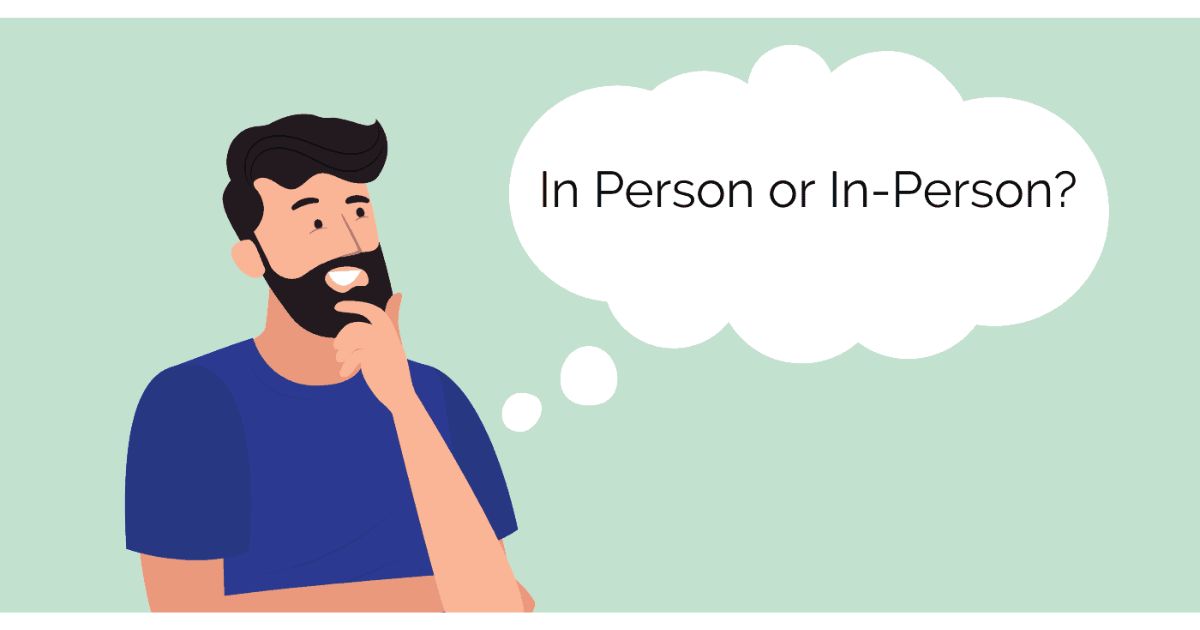Have you ever wondered whether to write “in person or in-person“? These phrases look similar, but they’re used differently. Understanding when to use each can improve your writing and communication.
In this article, we’ll explore the difference between “in person” and “in-person”. We’ll look at their meanings, how to use them correctly and provide examples. By the end, you’ll be able to use these phrases with confidence in various situations.
In-Person
“In-person” is used as an adjective. It describes nouns. It means something happens face-to-face, not online or virtually.
“In-person” often appears in business or educational contexts. It’s common when talking about events, meetings, or classes.
Examples:
- We’re having an in-person meeting tomorrow.
- The school is returning to in-person classes next month.
Read This Article: 15 Other Ways To Say “Hope you’re having a good day”
When to Use “In Person”

Use “in person” when talking about how something is done. It shows that an action happens face-to-face.
“In person” is often used with verbs like meet, speak, or appear. It emphasizes the physical presence of someone.
Examples:
- I prefer to talk to my boss in person.
- She delivered the news in person instead of by email.
When to Use “In-Person”
Use “in-person” before a noun. It describes events or activities that happen in the same physical space.
“In-person” is useful when comparing physical activities to virtual ones. It clearly shows the difference between online and offline events.
Examples:
- The company is hosting an in-person conference this year.
- Students are excited about in-person graduation ceremonies.
Scenario Examples
In everyday life, we often need to choose between “in person” and “in-person”. These examples show how to use each phrase correctly in different situations.
Let’s look at some common scenarios where you might use these terms. Understanding the difference can help you communicate more clearly.
Professional Settings
In the workplace, using “in person” and “in-person” correctly is important.
For example, a manager might say, “I want to discuss your performance in person.” This means the manager wants to have a face-to-face conversation.
On the other hand, you might see a memo saying, “We’re having an in-person meeting next week.” This tells employees that the meeting will be physical, not virtual. The hyphen in “in-person” shows it’s describing the meeting.
Read This Article: Words That Start With N and End With G
Event Planning
When planning events, the difference between these terms matters. An invitation might say, “Please RSVP in person at our office.” This means you need to go to the office to respond.
For a conference, you might see, “We offer both virtual and in-person attendance options.” Here, “in-person” describes a type of attendance. It means you can be there physically.
Personal Interactions
In personal life, these phrases have slightly different uses. You might tell a friend, “I want to apologize in person.” This shows you want to say sorry face-to-face.
If you’re organizing a family reunion, you might write, “We’re excited for our first in-person gathering in two years!” The hyphen “in-person” describes the gathering as a physical event.
Navigating Grammar and Style
Grammar can be tricky. But understanding it helps us use words correctly. Let’s look at how grammar affects “in person” and “in-person”.
“In person” follows basic grammar rules. “In” is a preposition. “Person” is a noun. They work together to describe how something happens. For example: “I like to shop in person.”
Grammar Rules
“In person” is two separate words. It’s often used as an adverb. This means it describes how an action happens.
For instance: “Let’s meet in person to discuss the project.”
“In-person” is different. It’s a compound adjective. The hyphen joins the words. It describes a noun.
For example: “We’re having an in-person meeting tomorrow.”
Stylistic Considerations
Style can change how we use words. “In person” often sounds more formal. It’s good for professional writing. You might see it in business emails.
For instance: “The CEO will deliver the speech in person.”
“In-person” can feel more modern. It’s common in casual writing. You’ll often see it in event announcements.
For example: “Join us for our in-person yoga class this Saturday.”
Read This Article: Time Flys or Time Flies – Correct Usage?
Conclusion
Choosing between “in person” and “in-person” doesn’t have to be confusing. “In person” is an adverb that describes how an action happens.
“In-person” is an adjective that describes nouns. By keeping these rules in mind, you can use them correctly in your writing and speech.
Practice using these phrases in your daily life. Pay attention to how others use them. With time, you’ll find it becomes natural to choose the right form.
Clear communication is important, and understanding these small details can make a big difference in how you express yourself.
FAQs
What is the difference between in person and in person?
“In person” (two words) is an adverb describing how an action happens. “In-person” (hyphenated) is an adjective describing a noun. They’re used in different contexts but both refer to physical presence.
How do you say meeting in person?
You can say “Let’s meet in person” or “We’re having an in-person meeting.” The first uses “in person” as an adverb, while the second uses “in-person” as an adjective modifying “meeting.”
What is a meaning of in person?
“In person” means physically present or face-to-face, as opposed to communicating remotely or virtually. It emphasizes direct, personal interaction.
Is it grammatically correct to say person?
Yes, “person” is a grammatically correct noun. If you’re asking about “in person,” it’s correct when used as an adverb. For the adjective form, use the hyphenated “in-person.”

Jack Sterling, the voice of LifestyleTalk, shares insights on wellness, travel, and personal growth. Join him for tips and inspiration to enrich your everyday life.









